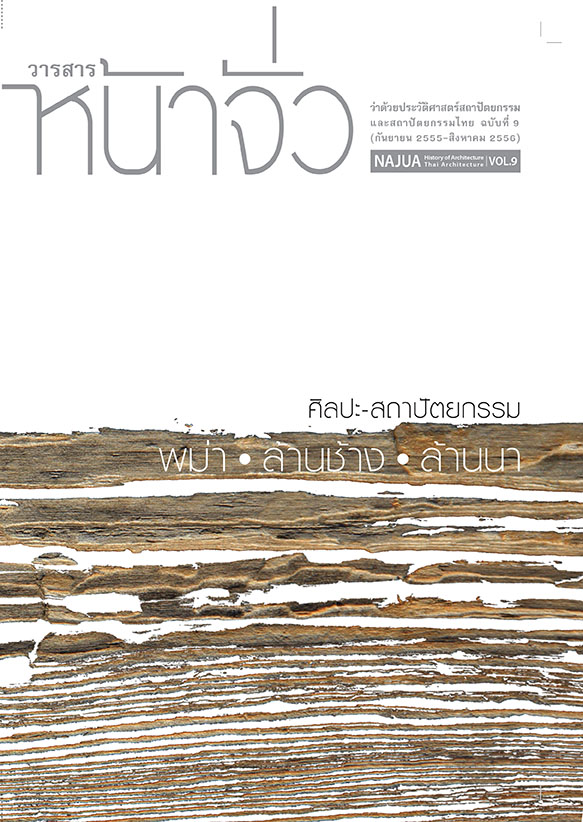ปานปุรูปซงเจาง์ เมืองสะเล พม่า Pan-pu-youp-soum Kyaung, Sa-le, Myanmar
Main Article Content
Abstract
บทคัดย่อ
ปานปุรูปซงเจาง์ เมืองสะเล เป็นสังฆิกวิหารไม้ที่ประดับด้วยภาพจำหลักรูปบุคคลอันเป็นสังฆิกวิหารที่มีชื่อเสียงของพม่า สะเลปานปุรูปซงเจาง์สร้างโดยพ่อค้าเนื้อวัวเพื่อถวายเป็นที่จำพรรษาแก่พระอูกุณะ ไกน์เธาก์สยาดอของพระภิกษุนิกายสุธรรมะ และเป็นพระอาจารย์ของพระมเหสีเซนดนของพระเจ้ามินดง สะเลยังเป็นเมืองที่พระมเหสีเซนดนทรงได้รับส่วยเป็นผลประโยชน์ สะเลปานปุรูปซงเจาง์ประกอบด้วยอาคารย่อย 6 หลัง คือ อาคารประดิษฐานพระพุทธรูป อาคารเชื่อมต่อ อาคารเก็บพระคัมภีร์ อาคารหลัก อาคารสำหรับเรียนหนังสือของพระภิกษุหรือสามเณร และอาคารห้องเก็บของ ความสำคัญของสะเลปานปุรูปซงเจาง์อยู่ที่ภาพจำหลักไม้จากเนื้อเรื่องในคัมภีร์ชั้นอรรถกถาของชาดกธรรมบท เปตวัตถุ และสุตตนิบาต ในพระสุตตันตปิฎก ได้แก่ ภูริทัตชาดก จุลลปทุมชาดก มหาวาณิชชาดก อุมมาทันตีชาดก วิธูรชาดก วรุณชาดก และกุณาลชาดก ธัมมปทัฏฐกถา อาทิ อนาถบิณฑิกเศรษฐี อุปกาชีวก บุตรเศรษฐีมีทรัพย์มาก พระสุนทรสมุทรเถระ เรือนจำ สญชัย นางปฏาจารา พระโชติกเถระ และพระขทิรวนิยเรวตเถระ รวมทั้งเขตตูปมาเปตวัตถุ (ว่าด้วยพระอรหันต์เปรียบเหมือนนา) และอุปกาชีวกในสุตตนิบาต รวมทั้งนิทานพื้นบ้านพม่าเรื่องมะชเวอูและชเวพีญเล ภาพจำหลักของนิทานในคัมภีร์อรรถกถาและนิทานพื้นบ้านเหล่านี้คงมีวัตถุประสงค์เพื่อใช้ประกอบการสอนจริยธรรมและให้คติเตือนใจแก่ฆราวาสรวมทั้งพระภิกษุและสามเณร เนื่องจากตำแหน่งของภาพจำหลักอยู่ภายนอกอาคารด้านหน้าที่เห็นได้ง่าย ประกอบกับเจาง์พม่าทำหน้าที่เป็นศูนย์กลางการศึกษาด้านจริยธรรมและวัฒนธรรมพม่าในชุมชน รวมทั้งอาจสะท้อนกระแสชาตินิยมพม่าที่ต่อต้านการครอบงำของวัฒนธรรมตะวันตก เมื่อพม่าตอนบนตกเป็นเมืองขึ้นของอังกฤษในปี ค.ศ. 1885 และอังกฤษส่งเสริมการศึกษาสมัยใหม่มากกว่าการศึกษาแบบเดิมในวัดทางพระพุทธศาสนา สะเลปานปุรูปซงเจาง์ถวายให้เป็นที่อยู่ของพระสงฆ์ในปี ค.ศ. 1892
Abstract
Pan-pu-youp-soum Kyaung, Sa-le is a well-known Burmese Buddhist monastery adorned with wood-carvings of human figures. It was built by a beef trader to donate to U Guna, a Burmese monk who was a gaing-htauk sayadaw [assistant monk leader] of Thudhamma Nikaya and a monk teacher of King Mindon and Queen Seindone. Sa-le was an appanage town of Queen Seindone. Sa-le Pan-pu-youp-soum Kyaung includes six minor halls or buildings; namely, the Buddha hall, connection hall, hall for Buddhist scriptures, main hall, study hall, and storage room. It is most significant for its wood-carvings in high relief depicting scenes of Buddhist stories from the Commentary of Khuddaka Nikaya, Sutta Pitaka; such as dhammapada [the path of dhamma], sutta nipata [the Sutta collection], petavatthu [stories of hungry ghosts], and jataka [birth stories]. Jataka stories include the Varana, Culla Paduma, Maha Vanija, Ummadanti, Kunala, Bhuridatta, and Vidhura jatakas. Dhammapada comprise stories of Anathapindika; Upaka; Mahadhana, the treasurer’s son; Monk Sariputta; Nun Patacara; Venerable Revata; a courtesan tempting a monk (Sundara Samudda); Ajatasattu’s attacks on Jotika’s palace; and the Prison-House. Wood-carvings also depict scenes of the story of a wealthy man’s son in khettupama, petavatthu; the continued story of Upaka in sutta nipata; and a Burmese folktale of Ma Shwe-U and Shwe-phjin-le Nat. These wood-carvings aimed to provide Buddhist moral teachings to laymen as well as monks and novices since they were adorned on balustrades and outside walls on the front of a study hall. Kyaung in Burmese means a monastery and a school; it is a center of Burmese education where Burmese culture has been preserved. Sa-le Pan-pu-youpsoum Kyaung probably reflected Burmese nationalism and opposed British and Western influences after the whole of Burma fell under British rule in 1885 and the British introduced modernized British education. Sa-le Pan-pu-youp-soum Kyuang was donated to U Guna and monk communities in 1892.

